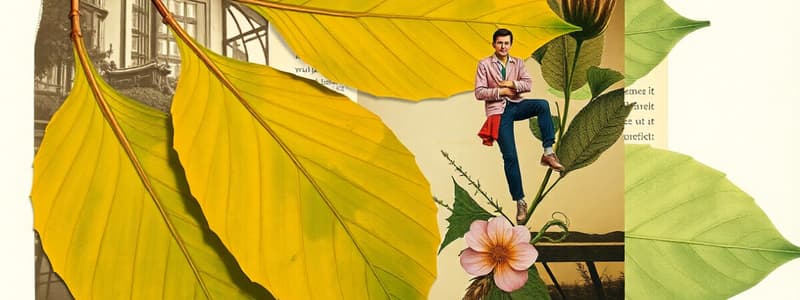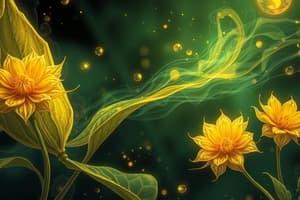Podcast
Questions and Answers
What is the characteristic shape of Cassia auriculata?
What is the characteristic shape of Cassia auriculata?
- Long and narrow (correct)
- Short and wide
- Round and thick
- Flat and broad
How many layers does the upper palisade have in Cassia auriculata?
How many layers does the upper palisade have in Cassia auriculata?
- Four layers
- One layer
- Two layers (correct)
- Three layers
What color is associated with Cassia auriculata when treated with H2SO4?
What color is associated with Cassia auriculata when treated with H2SO4?
- Crimson red (correct)
- Yellow
- Green
- Blue
What does the 'long leaf (3x)' description refer to in Cassia auriculata?
What does the 'long leaf (3x)' description refer to in Cassia auriculata?
What aspect of Cassia auriculata is indicated by the location 'KSA'?
What aspect of Cassia auriculata is indicated by the location 'KSA'?
What structure is represented in the T.S. diagram of the senna leaflet?
What structure is represented in the T.S. diagram of the senna leaflet?
Which part of the leaf anatomy is specifically indicated as pericyclic fibres?
Which part of the leaf anatomy is specifically indicated as pericyclic fibres?
In the context of leaf anatomy, what is the primary function of pericyclic fibres?
In the context of leaf anatomy, what is the primary function of pericyclic fibres?
Which of the following structures would NOT be visible in a T.S. diagram of a senna leaflet?
Which of the following structures would NOT be visible in a T.S. diagram of a senna leaflet?
How does the arrangement of pericyclic fibres contribute to the overall structure of the senna leaf?
How does the arrangement of pericyclic fibres contribute to the overall structure of the senna leaf?
Flashcards
Cassia auriculata
Cassia auriculata
A plant, possibly a type of acacia, known for its long, narrow, and possibly three-fold leaves.
Leaf shape (Cassia)
Leaf shape (Cassia)
Long and narrow, possibly three times longer than wide.
Upper Palisade Layers
Upper Palisade Layers
Two layers of cells in the upper part of the leaf.
Crimson Red Color
Crimson Red Color
Signup and view all the flashcards
H2SO4 Reaction
H2SO4 Reaction
Signup and view all the flashcards
Argel leaf
Argel leaf
Signup and view all the flashcards
Leaf Anatomy
Leaf Anatomy
Signup and view all the flashcards
Pericyclic fibres
Pericyclic fibres
Signup and view all the flashcards
T.S.Diagram
T.S.Diagram
Signup and view all the flashcards
Senna leaflet
Senna leaflet
Signup and view all the flashcards
Study Notes
Pharmacognosy-I Lecture 6: Medicinal Leaves
- Lecture covers Senna leaflets, specifically Cassia acutifolia Delile, Cassia angustifolia Vahl, and variations
- Senna leaflets are dried leaves of paripinnate plant
- Senna leaflets belong to the Leguminosae family ( Fabaceae ), Caesalpinoideae subfamily
- Two classifications exist: Alexandrian/Khartoum senna and Tinnevelly/Indian senna
- Senna leaf can be distinguished by leaflet size, midrib impression, symmetry of leaflet base, stomatal index, and vein-islet number.
- Microscopical characteristics for Alexandrian senna include numerous hairs, stomata with two subsidiary cells, vein-islet number between 25.0-29.5 and stomatal index between 11.4-13.0
- Microscopical characteristics for Indian senna include less numerous hairs, stomata with two or three subsidiary cells (ratio approximately 7-3), vein-islet number between 19.5-22.5 and stomatal index between 17.1-20.0.
- Substitutes for Senna includes Cassia obovata (dog senna), Cassia auriculata, Solenstermma argel
- Solenstermma argel is found in upper Egypt, has a bitter taste and wrinkled/twisted leaves; distinguished from Senna by its anthracene free structure
Ginkgo Leaves
- Ginkgo leaves are dried leaves of Ginkgo biloba F. Ginkgoaceae
- Ginkgo leaves are fan-shaped, having a deeply notched apex.
- Leaf margins range from entire (lower portion) to finely notched or crenate (upper portion)
- Leaves have a symmetric base, green to brownish yellow color, and feature a characteristic odor and bitter taste.
Active Constituents of Ginkgo Leaf
- Standardized Ginkgo Leaf extract contains flavonoids (25%), sesquiterpenoids (e.g., bilobalide, 3%), diterpenoids (e.g., gingkolides A-C, 3%), condensed tannins (catechol), and amino acids.
Claimed uses of Ginkgo extract
-
Age-related physical and mental deterioration
-
Schizophrenia (120-240mg) for 3-6 months.
-
Alzheimer's disease and dementia
-
Cardiovascular disease (decrease in oxidative stress)
-
Cerebral vascular insufficiency.
-
Impaired cerebral performance, including loss of memory, alertness, and depressive mood.
-
Vertigo and altitude sickness
-
Tinnitus (ringing in the ear)
-
More research is needed to support Ginkgo's effectiveness due to conflicting results
Hamamelis Leaves (Witch-hazel)
-
Dried leaves of Hammamelis virginiana F. Hammamelidaceae
-
Active constituents are 10% tannins, including condensed (catechol) and Hamamelis tannins (pyrogallol or hydrolyzable tannins)
-
Uses:
- Astringent for dry/cracked skin
- Haemostatic for hemorrhoids, minor blood extravasations
- Calming and healing on irritated red skin
- Local anti-inflammatory
Hedera Helix Leaf (Ivy)
- Dried leaves of Hedera helix, belonging to the Araliaceae family
- Native to Europe and Western Asia
- Claimed uses (clinical studies): Expectorant and bronchodilator (chesty cough relief)
- Anti-inflammatory, antispasmodic, antimicrobial activities
- Traditional use in gout and rheumatism.
Active constituents of Hedera Helix Leaf (Ivy)
- Triterpene saponins : hederasaponnins A-I
- Hederasaponin C (hederacoside c) is a significant compound
- Flavonoid glycosides (rutin and quercetin)
- Phenolic acids
- Alkaloid (emetin)
Studying That Suits You
Use AI to generate personalized quizzes and flashcards to suit your learning preferences.




